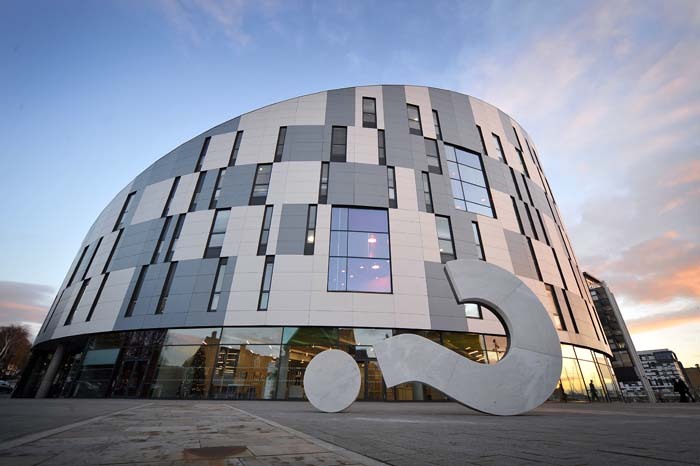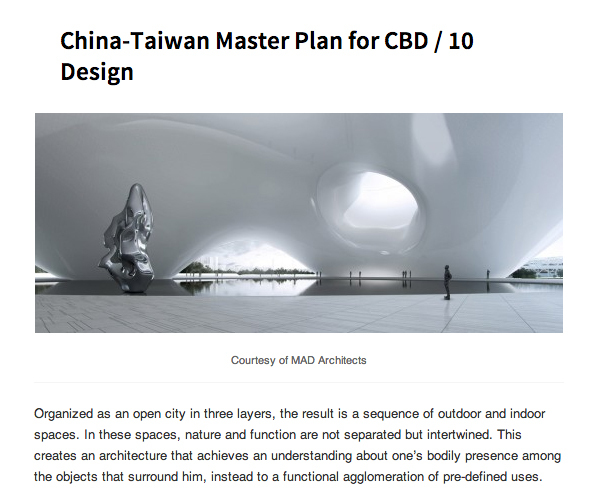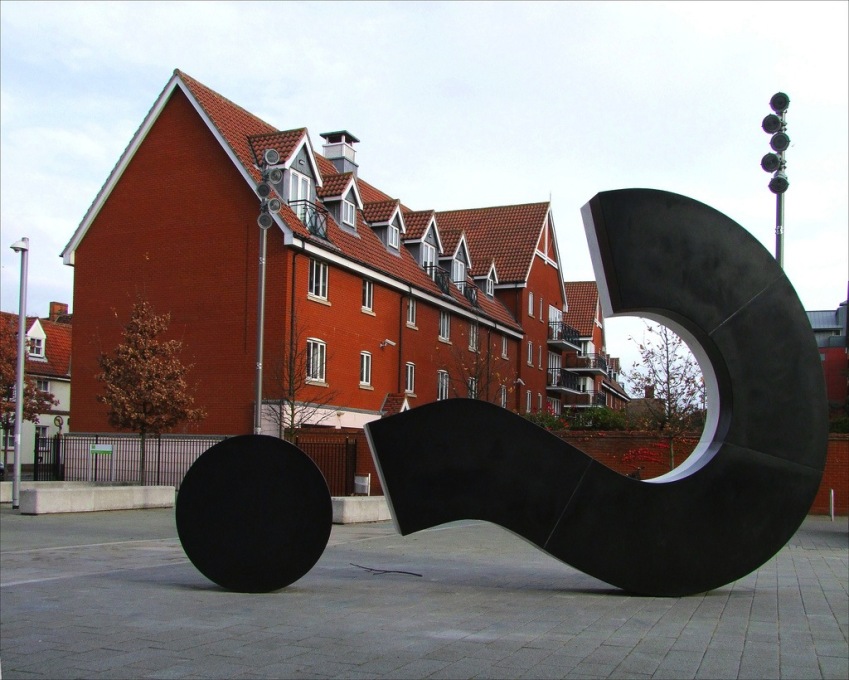The art world loves to talk about itself. Lately, it’s talking about the way it talks about itself – through International Art English, or the unintelligible language of the art press release. We think it’s time to ask: is there an International Architecture English too?
--
“A man may take to drink because he feels himself to be a failure, and then fail all the more completely because he drinks. It is rather the same thing that is happening to the English language. It becomes ugly and inaccurate because our thoughts are foolish, but the slovenliness of our language makes it easier for us to have foolish thoughts...If thought corrupts language, language can also corrupt thought.”
So wrote George Orwell in his 1946 essay “Politics and the English Language.” As proof of the alcoholic gutter that English had fallen into, in his diatribe he quoted political pamphlets and newspaper articles whose syntax was convoluted, pretentious, and obscure. Read in today’s context, these examples of writing whose hallmarks are “staleness of imagery” and “lack of precision” sound remarkably contemporary – but not like something you’d find in The New Yorker... more like something you’d lazily skim in a press release about art or architecture.
Last summer, the online magazine Triple Canopy published an article by Alix Rule and David Levine called International Art English: On the rise – and the space – of the art-world press release, which met with considerable hype. By no means the first critical incision into the impenetrable, often absurd jargon surrounding contemporary art, Rule and Levine’s analysis employed a new tactic: science. Attempting to statistically analyze the language used by the most prolific, prevalent, and popular online art-PR-blaster, e-flux, they fed every press release e-flux has put out since the dawn of time into the language-analysis software program Sketch Engine. This program spits out lists of the words most commonly found in the corpus it’s analyzing and graphs them over a time period. It can also find patterns in root words, parts of speech, and syntactical construction. They used the British National Corpus (BNC), “standard English,” as a control group comparison.
Their findings were not surprising. For instance: “International Art English (IAE) is rife with spacey terms like intersection, parallel, parallelism, void, enfold, involution, and platform”; it contains a “frequency of adverbial phrases such as ‘radically questioned’”; and there are regular trends in word usage, like a spike in usage of the word “precarity” after 2008. Among the various (partly ironic) conclusions by the authors of the study is that IAE’s distance from the BNC allows the elites of the art world to identify each other. They also claim that criticism has become “high-brow copywriting” driven by market demands.
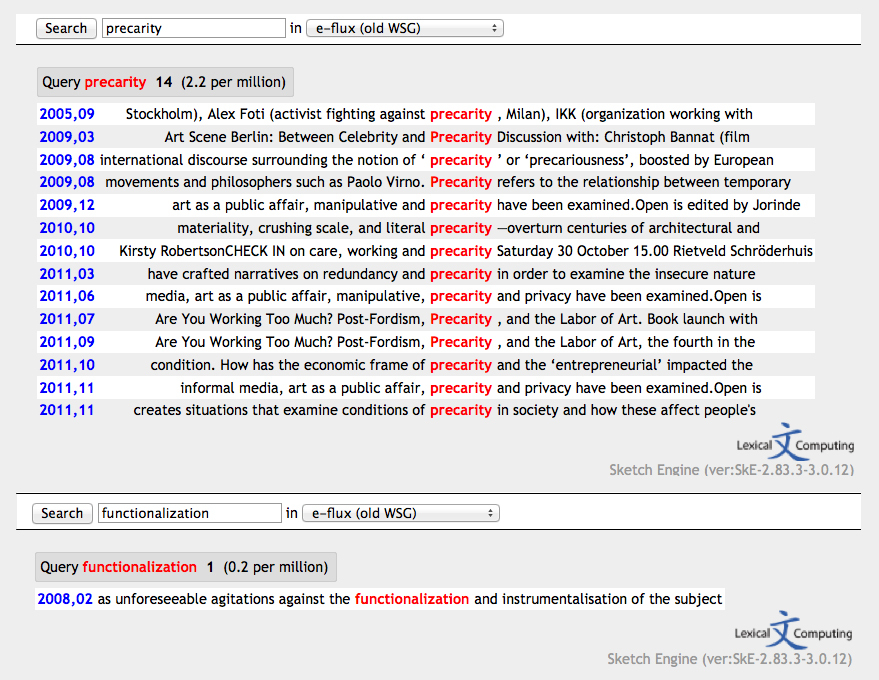
In the most recent issue of e-flux journal, there appeared two vehemently critical arguments against the Triple Canopy piece by artists/writers Hito Steyerl and Martha Rosler. What these arguments focused on was not so much the “Art” of IAE, but the “English.” That is, the fact that writing style has been proliferated, and in turn has been developed, by non-native English speakers. Rule and Levine mockingly refer to it as “badly translated French,” but why, Steyerl asks, should a Chinese intern be expected to churn out press releases in Standard English?
Everyone is boozing on IAE right now. It's because its discussion is able to morph to a discussion of any hot button art issue from “the crisis of criticism” to globalization to the market-driven art economy to unpaid internships to the cultural hegemony of institutions like e-flux. And this talk has been going on for...a long time. (A 2012 issue of frieze d/e was devoted to the topic.) Whether or not IAE is a cause or a symptom, talking about it has provided a way to talk about a lot of other important things.
Speaking of Architecture...
By now, someone standing on the architecture side of the news-media fence might ask: where’s the parallel discussion in architecture? Is there an International Architecture English, and if so, what state is it in? On the occasion of the 55th Venice Art Biennale, possibly the cultural event with the biggest PR-paper-trail in the world, it seems a prescient moment to see how language measures up across fields. Comparing the relationship between the rhetoric and the content it describes – art/buildings – could shed some light on both.
This April, architect Jan Loerakker made a foray into studying arch-speak, in many ways comparable to last year’s Triple Canopy piece. Though there’s no number crunching in this one, in The Day Architects Stopped Reading Newspapers (posted on the Failed Architecture blog), Loerakker focuses on ArchDaily’s stream of press releases. ArchDaily, the most-read architecture blog online, is the ideal e-flux analog: it pushes constant press updates consisting of copy/pasted project descriptions, and it also has a forum for slower, more in-depth and critical texts. Like Rule and Levine, Loerakker focuses on the cheap stuff, the press releases – which are just as laughably convoluted as you’d expect. And at a cursory look, the language of the architecture press release seems to follow a lot of the same patterns as IAE does...albeit with a lot more technical details like square footage.

Skimming through tens or hundreds of project descriptions, you’ll continually run into these claims about whatever architecture is being pimped out: (1) its design is sustainable (2) it incorporates the local culture and site (3) it’s classic yet modern (4) it will make everyone’s life better. These may be platitudes, and we may not pay them much attention...but occasionally they are also straight-up lies. As Loerakker aptly points out, the problem with recycling vapid info-texts straight from the architects without fact-checking them, is that it potentially skirts, obscures, or downright denies the political/environmental/social problems behind the façade. If a building’s positive public image can be bought for the price of an advertisement disguised as “news,” who’s going to shoulder the burden of criticality – and risk losing ad revenue?
Architecture is obsessed with images way more than it is with text. At best, you’re skimming a word here and there between pornographic hi-res renderings as you vacantly scroll down the ArchDaily screen. But these renderings are certainly as euphemistic as the text that accompanies them. The artificiality of the images and the text go hand-in-hand. They mutually reinforce each other. Your eyes glaze over.
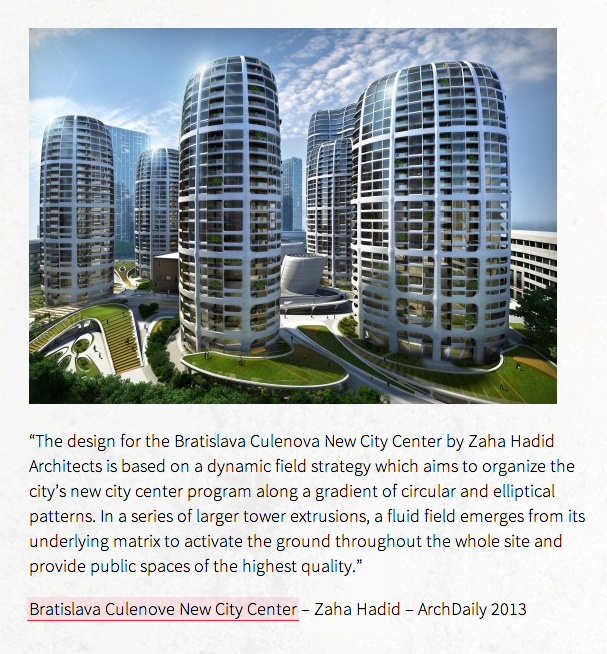
Habits vs. Problems
The question remains: does this fluff matter? Steyerl says we should either think about it as spam or as pure poetry (or both). Press releases are minor cogs that drive the institutional machines they serve – a totally banal aspect of the art/architecture industries. And one might hope that those of us who spend time poring over blogs have developed a critical eye; as the sheer quality of crap proliferates, our critical faculties should sharpen in turn. The most valuable skill of the internet age, after all, is the ability to discern, select, and filter, sifting through large quantities of multimedia materials for both the odd nugget of content and an assessment of the broader picture – finding the pearls and then stringing them together. Massimiliano Gioni’s The Encyclopedic Palace theme for this year’s Biennale is a direct expression of this contemporary skill and desire.
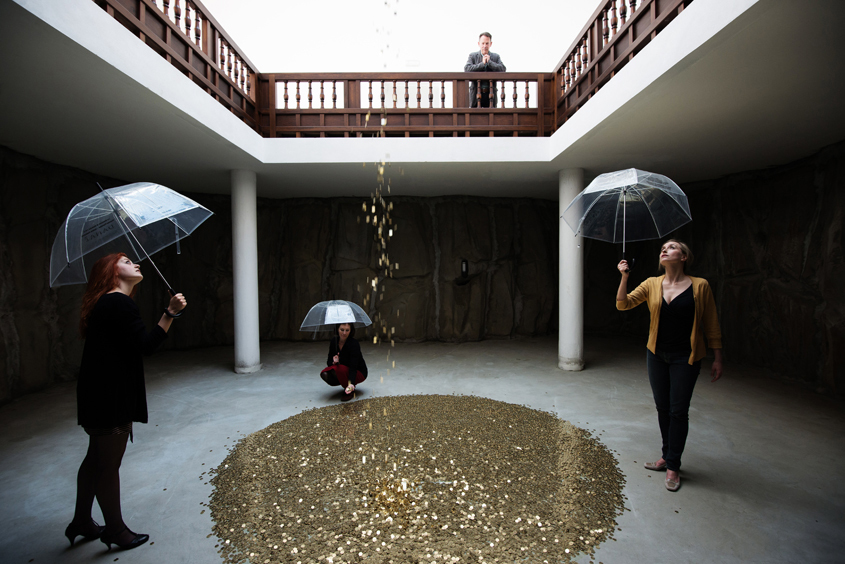
And yet, Orwell might argue that when language “takes to drink,” we get drunk too, and we forget how to read in general. Or forget to arch a critical eyebrow when looking at a nice picture. It’s possible that PR-style writing, whether or not we know it to be an advertising tool, makes it harder to locate any given piece of writing on the continuum of advertisement>news>criticism.
Along these lines, Steyerl suggests that time could be better-spent collecting data about real-life atrocities that are obscured by euphemistic art-speak. Like when art or architecture become vehicles for money laundering, or when oligarchs suddenly need a local art world like they need a new handbag – when the value of “culture” outweighs the value of human rights (re: uncube's coverage of the Guggenheim Abu Dhabi and Mostafa Heddaya’s excellent text When Artspeak Masks Oppression). This is precisely the danger of euphemistic rhetoric that Orwell was talking about.
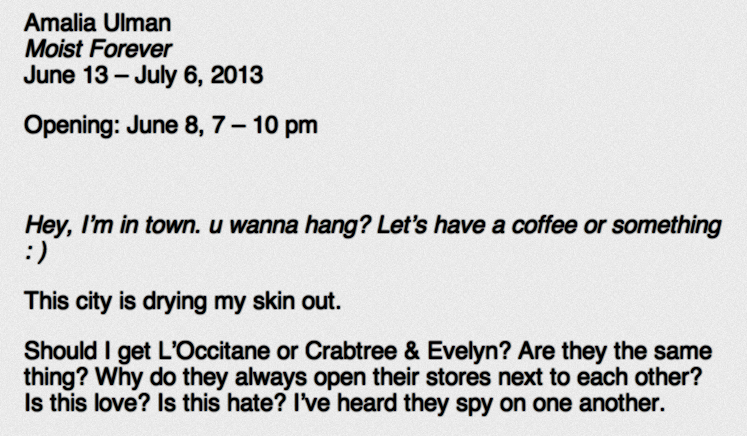
Like art texts, a possible majority of architecture texts are written by non-native English speakers. To clarify: I am not comparing non-native English speakers to drunks. On the contrary – the adoption and translation of language is precisely what allows us to understand how said language is functioning in various contexts. Beginning a conversation about language in architecture could shed some light on the behind-the-scenes infrastructure of the architecture world. The question is not whether one should speak fluent IAE; it's why we need a rapid-fire succession of brand-new buildings with shiny press packages at all.
There are a million ways to present a building in space – more than enough to fill a biennale – and there are as many ways to write about it. Architecture should sober up and join the conversation about conversation, both by borrowing from the IAE debate and by inventing its own vocabulary to reflect on itself. Architects Anonymous, if you will.
- Elvia Wilk, Berlin




